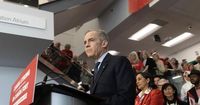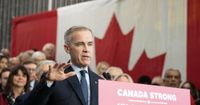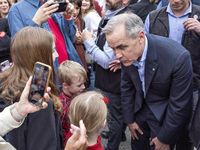WHITBY, ONT. — The Liberal Party of Canada unveiled an ambitious election platform on April 19, 2025, pledging nearly $130 billion in new measures over the next four years. This marks a significant shift in priorities from the party's previous direction under former Prime Minister Justin Trudeau. Liberal Leader Mark Carney released the platform following the conclusion of the only two leaders' debates of the campaign, coinciding with the start of advanced voting.
Carney, addressing supporters at Durham College, emphasized the need for substantial government investment amid ongoing economic challenges, stating, "It’s time to build again, big time." The platform outlines plans to add $35.2 billion in new spending and tax cuts over the next year, contributing to a total of $129 billion in expenditures over four years. However, this spending spree is projected to increase the federal debt by $225 billion.
The Liberal platform aims to balance the operating budget by 2028, but it also anticipates a capital budget deficit of $48 billion that year. The plan includes a $20 billion income tax cut and significant investments in various sectors, including housing, defense, and healthcare. Notably, the platform allocates $30.9 billion to defense spending over the next four years, aimed at meeting NATO's target of 2% of GDP by 2030.
Carney criticized the previous government for excessive operational spending without sufficient investment, asserting that the new strategy would focus on stimulating private-sector investment. The platform reflects a reversal in the allocation of funds, with 64% directed towards capital projects compared to just 33% for operations. This shift aims to foster a more robust economic environment amid uncertainties stemming from a trade war with the United States.
Among the notable features of the platform is a commitment to create an in vitro fertilization (IVF) program that would offer Canadians up to $20,000 for treatment cycles, costing approximately $103 million annually. This initiative reflects a broader commitment to enhancing healthcare services, alongside pledges to improve mental health programs and establish more medical residency positions.
Carney's proposal also includes a significant commitment to housing, with plans to double the pace of home building through the establishment of a new agency called Build Canada Homes (BCH). This initiative is expected to cost about $3 billion annually over the next four years and aims to address the ongoing housing crisis across the country.
In addition to housing and healthcare, the platform details measures to enhance national security and defense capabilities. The Liberal government plans to invest in new equipment for the Canadian Armed Forces (CAF), increase pay for military personnel, and address issues of sexual misconduct within the ranks. Carney's platform promises a comprehensive approach to defense, ensuring that Canada is equipped to respond to growing global threats.
However, the ambitious nature of the platform has drawn scrutiny from opposition leaders. Conservative Leader Pierre Poilievre labeled the plan as shocking, arguing that it would lead to ballooning deficits and higher costs for Canadians. Poilievre's criticisms reflect a broader concern among some voters regarding the sustainability of such extensive spending commitments.
Carney defended the Liberal platform, stating that it is designed to be prudent while also bold in its vision for Canada's future. He acknowledged the challenges posed by the current economic climate, particularly the impact of U.S. tariffs on Canadian trade. The platform includes provisions for a counter-tariff response, which is expected to generate $20 billion in revenue.
As the election campaign progresses, the Liberal Party is positioning itself as a champion of investment and growth, aiming to attract private-sector participation in rebuilding Canada's economy. Carney's rhetoric emphasizes the need for government leadership during times of economic uncertainty, asserting that it is the role of governments to catalyze private investment.
Despite the ambitious spending plans, there remains skepticism about the feasibility of achieving a balanced budget while simultaneously increasing spending in various sectors. Critics have pointed out that previous governments have struggled to deliver on similar promises, leading to concerns about the potential for increased national debt.
The Liberal platform also seeks to address longstanding issues related to veterans' support, with promises to enhance benefits and ensure that female veterans receive adequate assistance. This commitment reflects a recognition of the sacrifices made by those who have served in the military and an acknowledgment of the need for improved support systems.
As the election date approaches, the Liberal Party faces the challenge of convincing voters that its ambitious plans are both achievable and necessary. Carney's leadership will be put to the test as he navigates the complexities of the current economic landscape, balancing the need for investment with the imperative to maintain fiscal responsibility.
In a world of growing threats and economic uncertainty, the stakes are high for the Liberal Party as it seeks to secure its position in the upcoming election. With a platform that promises significant changes and investments, the party aims to resonate with Canadians looking for bold leadership in challenging times.






